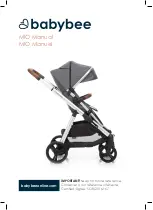
EN
81
connected during each charging cycle, because this would result in the formation of too much gas
and risk overheating the battery.
NOTE:
• If external conditions or connected loads prevent the voltage remaining constant during all of
the constant voltage charging, the charge controller detects how long the voltage has been
held constant. When this time amounts to 3 hours the charge controller switches to trickle/
float charging.
• The charge controller is as standard set for equalisation charging of the battery once a
month.
TRICKLE CHARGING
When the constant voltage charging is completed the charge controller reduces the charging current
to the set point value for trickle charging. During this stage there are no further chemical reactions in
the battery plates – all of the supplied charging current is converted to heat and the formation of gas.
The purpose of trickle charging is to compensate self-discharging of the battery, leakage current and
other small losses in the system, so that the battery remains fully charged and at full capacity.
The connected loads are run almost completely from the solar panel when trickle charging is in
progress. If the power from the solar panel is not sufficient the charge controller will not be able to
maintain the battery voltage in the trickle charging. If the battery voltage drops below the level for
recharging, the charge controller switches back to bulk charging.
INSTALLATION
GENERAL
• Read all the installation instructions before starting the installation.
• Be careful when installing batteries, especially lead-acid batteries with traditional, wet cells.
Wear safety glasses and keep clean water handy to quickly rinse off any splashed battery acid.
• Always keep batteries at a safe distance from metal objects – they can cause short circuiting
between the battery terminals.
• Make sure there is adequate ventilation – batteries can produce explosive gas when charging.
• Separate ventilation should be arranged for installation in enclosed areas. The charge controller
must not be installed in an enclosed area together with wet cell batteries – fumes from the
battery cells corrode and destroy their control circuits.
• Check that the power connections are firmly tightened and that all the leads are in good
condition to minimise loss of power and the risk of overheating and fire. There is a greater risk in
mobile installations – fasten all the cables with cable clips and protect all the connections from
vibrations.
• Lead-acid batteries or lithium batteries should preferably be used. Consult the battery
manufacturer if other types of batteries are going to be used.
• One or more batteries can be connected. The following instructions refer to systems with one
battery, but the connections are done in the same way when a group of several batteries is used.
Содержание 010501
Страница 3: ...1 2 1 2 3 4 5 6 7 8 9 ...
Страница 4: ...3 4 4 2 1 3 5 6 2 1 3 4 5 6 ...
Страница 5: ...5 6 1 2 3 4 5 6 7 8 9 10 11 13 12 9 ...
Страница 6: ...7 8 ...
Страница 7: ...10 9 ...
Страница 8: ...11 12 A B C D ...













































